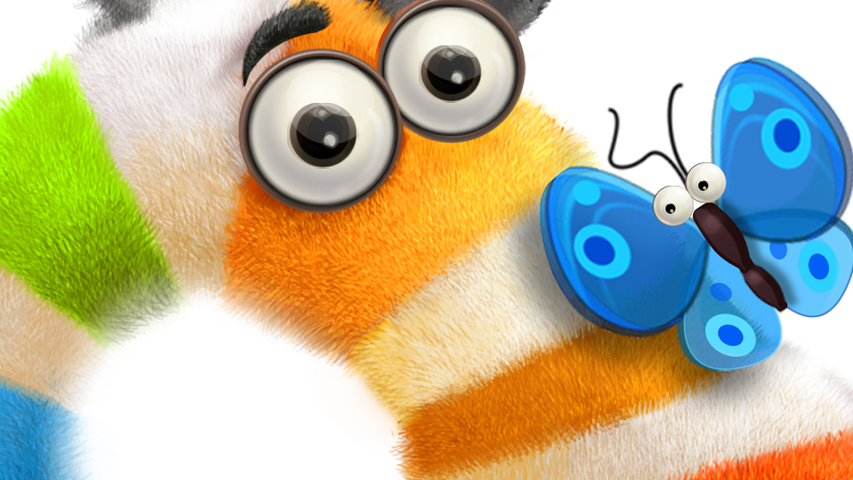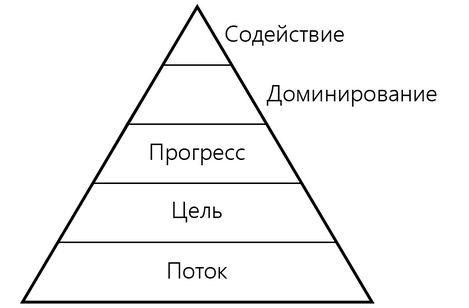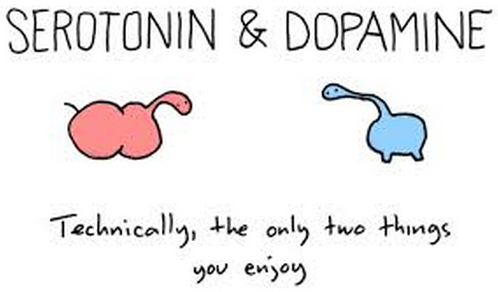The authors of the iOS application “Skazbuka” (PlayBC) – the GrommGame team – shared with App2Top.ru the results of a two-year study of the links between patterns in thinking and games, resulting in a new game theory.

Why do we like to play? Why do we combine such a variety of mechanics, from Tetris to football, into one category “game”? We at GrommGame assumed that game mechanics exploit certain thinking algorithms.
The game gives joy. But joy, to simplify it, is a hormonal surge. It reinforces the animal’s effective, from the point of view of survival, behavior. If you understand the connections between the game and thinking, then you can minimize the number of mistakes that are made when developing games.
For two years we conducted research — we studied all available information about the motivation of animals and humans, conducted experiments. As a result, a “Pyramid of value formation” of a person appeared. It will be discussed below.
How do successful companies make games now? Overkill. Based on their previous experience, companies create dozens of prototypes, and only a few reach the release. We couldn’t afford it, we had to dig into the essence of the game.
In 2014, our first game “Skazbuka” was advertised in the Appstore like no other. At some point we were standing in four (4!) places on the main page in the Russian App Store. At the end of the year, the game was included in the list of the best games according to Apple. Few developers can boast of such results for the first game.
Of course, our experience helped us, because before the launch of the mobile direction (GrommGame is a structural division of the Trailer Studio), for ten years we were one of the leading studios in the Russian Federation specializing in video presentations and trailers. Many of the industry knows us.
There was another problem. The success of the game was cumulative: the underlying theory, advanced graphics, a fantastic voiceover and a children’s theme that is gaining popularity. This blurred the understanding of the effectiveness of the theory, which did not fully suit us. I wanted to be sure that the theory works. In the next game, we gradually switched to a new development algorithm.
First the theory, then the game. Any element of the game is implemented only if it is represented in the “Pyramid of project values“. It doesn’t matter if it’s the interface or the main gameplay. We make the assembly, look at the reaction of the players and the conversion. As a result, we first refine the theory, and only then adjust the game. Even when we were making Skazbuka, it was important for us not to copy elements, but to synthesize them from an understanding of goals and objectives. For synthesis, we use TRIZ (Theory of Inventive Problem Solving).
The “pyramid of value formation” consists of five layers. They are prioritized from bottom to top. In our view, it was in this sequence that they appeared in the course of evolution.
If we analyze the development of computer games, we will see that new mechanics appeared in a similar sequence. From the simplest games, such as snakes, to modern giants like Destiny or Clash of Clans, if you take the mobile direction.
Let’s analyze each layer.
Flow
It is based on a person’s desire to repeat the action that he has just performed. In many ways, this is how our smoking habit or love of seeds is formed.
When a person has performed an action, a neural circuit is formed. If a person performs the action again, the chain will strengthen. Stable circuits consume electricity and die slowly. The brain, in turn, does not want to give electricity to maintain the circuit just like that and requires that each circuit be used.
This is how all our habits and preferences are formed. This is especially important before the age of fifteen. During this period, a huge number of reserve connections between neurons are formed. This is how the body adapts to the environment. That’s why we love the games we played in childhood the most. That’s why “the grass used to be greener.”
This is how all games work. It doesn’t matter if it’s computer football or real football. On repeating the same type of actions. This is called “Flow”.
The game does not have to have one type of thread, it can be a cycle of several threads. The flow can have different duration of one repetition and different complexity.
It is important to highlight the flow mechanism and make sure that the player is not knocked out of it. For example, we fundamentally do not break the gameplay with menu screens. The user launches the application and immediately gets into the gameplay. And it goes to the menu only if you want to interact with it yourself.
You can read more about this formation in the book “Stream” by Micah Csikszentmihalyi.
Goal
The human brain is an incredible mechanism. In this case, the neocortex is of particular importance to us. Its main task is to build causal relationships. At every moment of time, he forms a lot of predictions about what is going to happen. If what happened coincides with the forecast or exceeds it, then the person receives a reward — the release of dopamine (accelerates the exchange of information between neurons). It is also, along with serotonin, called the hormone of happiness.
As you might guess, the causal relationship consists of cause and effect. The flow state, which has already been described, is responsible for the cause, but from the point of view of the brain, every action should have consequences. If the brain does not receive “consequences” in the form of realized or delayed results (the same goals), it is uncomfortable, and the level of dopamine in the blood will be lowered.
In Last of Us, every 20-30 minutes they talk about the goal of your current race. They show a building in the distance, or your partner is bleeding, and you need to have time to save him. The goal doesn’t have to be complicated at all. In the mobile game Crossy Road, the goal is to cross the road. It is understandable and is read by the brain instantly. And he doesn’t care that she’s unattainable.
Through a layer of goals, the user understands your game. If the game seems confusing, boring to the user, and the interface is incomprehensible, then there is a high probability that the goals in the game are not presented with sufficient quality. You can directly tell the player about the goals, but it’s much better when he understands the goal himself. By context. This is a more reliable causal relationship.
You can read more about the system of prediction and construction of cause-and-effect relationships in the book “Brain and Soul” by Chris Frith.
Progress
If a person is in a state of flow and the goal is clear to him, the next desire he has is the need to develop this state. This layer is tightly coupled with the previous one. A person on a hormonal level enjoys getting a new experience. We watch new movies, listen to new music, read new books.
This mechanism is responsible for the constant human desire to explore the world. And, of course, it is connected with survival. The more a creature knows about the world, the more likely it is to save its life.
We will not talk about the physiological binding in this case. The topic is so extensive that without revealing it completely, we will be forced to mislead. Let’s just note that the desire for the new is heterogeneous and has “kickbacks”. It works according to the principle of a motivational pair (alternation of striving for the known and the unknown):
There are many ways to make progress in the game. The most popular is the breakdown of the gameplay into levels. Even if the levels are exactly the same, the player feels satisfied, they move from level “23” to level “24″.
But there are also more cunning ones. For example, in Journey, as the game progresses, the hero grows a scarf. And this is a very important element of the game, it is possible that the game could not have developed without it. There are no levels or scarves in Crossy Road, where progress is ensured by the appearance of new characters, the more of them are open, the further you have gone.
In order to be able to build “progress” competently, I recommend reading the literature on screenwriting, they deeply understand the psychological aspects of development: stories, characters, actions, etc. You can start with the book “The Million Dollar Story” by Robert McKee.
Dominance
It’s simple: the need for dominance = the need for survival. Evolutionarily, it so happened that the one who dominated had the best food in the pack, the best females, the best car and was more likely to survive. Once he survived, he gave offspring. Natural selection, nowhere without it. Therefore, the need to be better than others is incredibly strong in each of us.
As soon as there is progress within the flow, you want to go through it faster than everyone else. Reflexively.
Dominance in games has a wide range of implementations. Starting with simple “score the most points” and ending with the coolest “gun” in the game. And I don’t care that this is a virtual item that I bought for real money. It is most pleasant to dominate over a close circle of people. Social mechanisms in games are mostly about this.
Read more about the animal instincts preserved in man in the book “Man as an animal” by Alexander Nikonov.
Assistance
Naturally, the assistance is also aimed at improving survival. And not only because of the physical strengthening of those who joined the group. Assistance allows you to accumulate knowledge about the world not within a person, but within a group, society, significantly increasing the volume and reliability of this knowledge. Thanks to this mechanism, such a phenomenon as “humanity” became possible.
Assistance is a multifactorial layer. We divide it into two components:
Shoulder feeling (mirror neurons). Scientists know the “Phenomenon of mirror neurons”: when you see the action of another person, the same areas are activated in your brain, as if you had performed this action yourself. In other words, the brain is bad at separating itself and other subjects.
If we combine the “Mirror Neuron Phenomenon” with the “Flow Phenomenon” discussed above, then we can deduce a simple rule: a person reflexively wants to do what other people do.
This is what Gippenreiter writes about in his work “Communicate with the child. How?”when he says about the I-message: “If you want your child to be polite, then do not tell him: “Try to be polite,” the phrase will be effective: “I try to be polite”” (indirect quote).
In social games, we are shown the achievements of our friends for this very purpose. For the same reason, we like to be part of a team, to feel involved with a big cause. Unfortunately, real wars are also part of this mechanism.
You can start getting acquainted with the phenomenon of mirror neurons by watching a small speech by Olga Svarnik.
Service (social capital). As already mentioned, the hormones of joy are supported only by the behavior of a creature that is effective from the point of view of evolution (survival). If you don’t dominate, then the only way to survive in the herd is to benefit the herd. The more benefits you bring, the higher your social capital. The lower the probability that they will be kicked out of the herd.
The legacy of our ancestors has a stronger impact on our lives than it seems at first glance. We do not want to benefit society because we are kind. This is how the animal reflex to survival, inherited from herd primates, works.
In games, this factor is most often exploited at the scenario level. The vast majority of players are fighting for the forces of good. They are trying to save the village from the terrible fire-breathing dragon. Along the way, having received a release of encouraging hormones for the accumulated social capital.
If you know a fundamental work about social capital, suggest it in the comments.
Over time, a third factor, not found at the moment, will appear.
Why did the first Doom make a breakthrough? It was one of the first games where all five layers were implemented: flow, goal, progress, dominance, assistance. The last point appeared with the development of multiplayer.
Each layer of the pyramid can have different implementation methods and different depths. The flow can be of the same type, as in Tetris, or it can be multifactorial, as in Last of Us. Assistance can be expressed through simple mechanisms of social farms or through complex ones when you defend yourself shoulder to shoulder from zombies in Left 4 Dead.
Through testing our games, we develop this approach to development. And one day we will present a complete model, and not the basics, as now. The pyramid of value formation allows you to build harmonious games that players like. Allows you to see where there are holes in games from the point of view of human thinking mechanisms. For example, in Skazbuka, the two upper layers are not implemented, since they have not yet been found by us at that time. And in Cardball (our new game), the problem areas are assistance and purpose. In other areas, of course, development is also required, for which we currently do not have enough resources.
We are moving cautiously, we have unique gameplay mechanisms in stock, but for Cardball we decided to resurrect and develop a long-forgotten one. Did you find out?
The main value of the pyramid is that it allows you to introduce new working game mechanics. Overcome the current crisis of the endless cloning industry. To develop consciously, and not by brute force. What is the difference between the right decision and the wrong one? Knowledge.
It is convenient to work with the pyramid. For example, it is easy to monitor the “blurred eyes” in development. All layers should develop evenly, without distortions. If you spend six months developing progress (for example, content), but lose sight of the development of other elements, this will negatively affect the game.
There is no word “game” in the name of the pyramid. We tried to shift the layers we found to other phenomena and were surprised. Movies, books, social networks, the process of driving a car, Apple products are formed in a similar way (and the company itself is developing within the same mechanics).
Pyramid allows you not only to create games and applications, but also much more. For example, the author of this text builds his family, company and this article in a similar way: flow, goal, progress, dominance, assistance.
And this is just one of the models within the framework of Mensology, the science of thinking, which we are developing. For GrommGame, games are a tool for human cognition.
GrommGame is just starting its journey. Thanks for attention.









